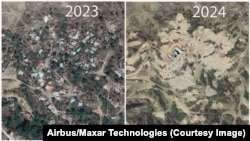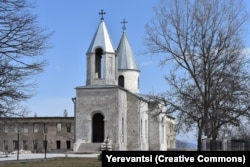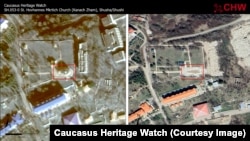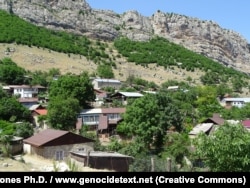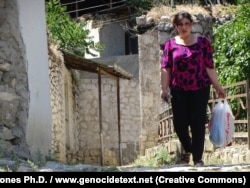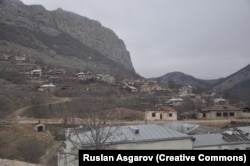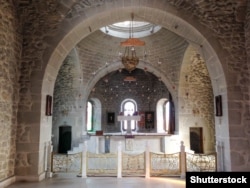A picture of a prayer session inside the St. John the Baptist Church in Nagorno-Karabakh was posted to Twitter by Azerbaijani parliament member Jala Ahmadova in July 2021 to demonstrate what she called an "atmosphere of ethnic and religious tolerance," after Azerbaijan recaptured Susa, a town known in Armenian as Shushi.
Today that church, built by Armenians in the 19th century, no longer exists.
Images released recently by the monitoring group Caucasus Heritage Watch indicate that the Susa church, which was wrapped in scaffolding through much of its time under Azerbaijani control, was demolished in the winter of 2023-24.
Baku retook control of Susa from ethnic Armenian forces in November 2020 after launching a war to retake territory internationally recognized as Azerbaijani land.
Two kilometers south of the erased church, satellite images released in April reveal that an entire village appears to have been razed to the ground. Today a large mosque is under construction in the broken soil where a settlement once stood, which was known in Armenian as Karintak and as Dasalti in Azeri.
Husik Ghulyan, a lead researcher at Caucasus Heritage Watch who published the satellite images of Dasalti/Karintak, told RFE/RL, "I think the goal of Azerbaijan in this case was to completely demolish [the settlement] to rebuild a new village for Azerbaijani internally displaced people or other resettlers."
The researcher said the village's church, visible to the right of the mosque, "is a legally protected heritage object even by Azerbaijani laws," which he said, was "probably the reason they left it intact."
Dasalti/Karintak, which means "under the rock," in both Azeri and Armenian, takes its name from the massive cliffs that loom above it. The village was the site of several natural springs and had a history of agriculture.
A traveler to the village in the late 1890s described it as a settlement where "the land is fertile, but the crops are scarce and produce little." Locals, the observer said, "planted wheat, barley, millet, and other crops." Under Soviet rule the village was home to a silk production plant and a factory making electrical components.
During the second Nagorno-Karabakh war in 2020, the village became a key battleground ahead of the fight for Susa. Images taken in December 2021 show bullet marks on buildings in the settlement, which resembles a ghost town in the photos after its ethnic Armenian population fled the Azerbaijani advance.
The most recent images of Dasalti/Karintak were made when Azerbaijani President Ilham Aliyev visited to oversee progress on a new mosque being built. Images released by Aliyev's office in July 2023 show houses in the settlement were still intact at that time but photos of Aliyev's late December visit to the village do not feature wide shots of the landscape, suggesting demolition work might have been under way by then.
Ali Mozaffari, an Iranian academic of Azerbaijani descent who is a senior research fellow at Australia's Deakin University, says the latest apparent drive to wipe out physical traces of Armenian heritage in Nagorno-Karabakh is an issue that may extend beyond a conflict between Baku and Yerevan. "There is a strong push, led by Turkey, for realizing the idea of a unified and connected Turkic World, and extending eastward to the Chinese border," Mozaffari told RFE/RL. "Heritage is very important to justifying this geostrategic vision," he said.
The academic adds that both Azerbaijan and Armenia have carried out well-documented cultural destruction, but says Baku has done so "more widely and systematically."
Lori Khatchadourian, an associate professor at Cornell University and the co-founder of Caucasus Heritage Watch, says the monitoring group has so far noted the destruction of 10 heritage sites within Azerbaijan's retaken territory since 2020 and is currently beginning a new survey of hundreds of heritage locations. She points to the precedent of the virtually complete erasure of Armenian heritage in the Azerbaijani exclave of Naxcivan as an example of what may lie ahead in Nagorno-Karabakh.
"One of the important lessons learned from the Naxcivan case is that total cultural erasure takes time," Khatchadourian told RFE/RL. "The demolition of the Armenian cultural landscape in that region unfolded over a decade, beginning in 1997 and continuing until at least 2009, and possibly as late as 2011."
The researcher says that, in the case of Nagorno-Karabakh, "this sad story is likely to play out over many years."
RFE/RL requested comment for this story from Azerbaijan's presidential administration on April 23 but received no response by the date of publication.




